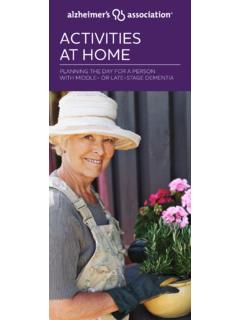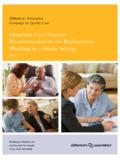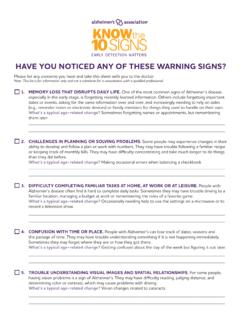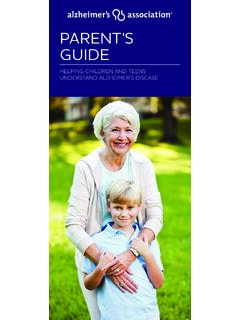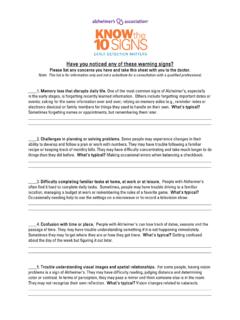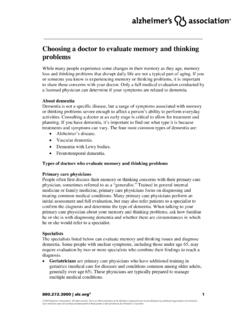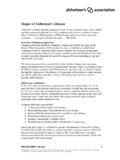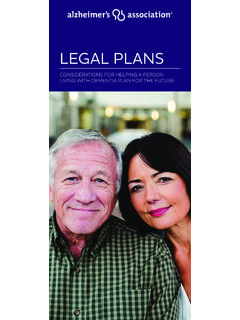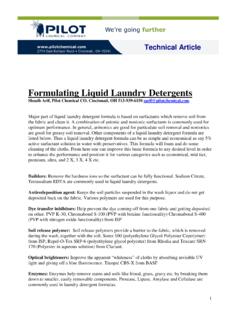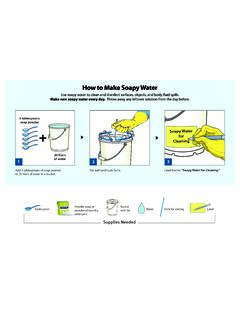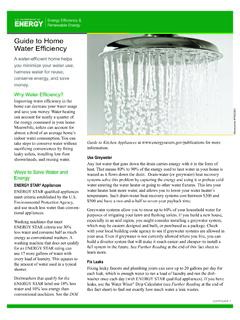Transcription of HOME SAFETY CHECKLIST - Alzheimer's Association
1 | 2022 alzheimer s Association . All rights reserved. This is an official publication of the alzheimer s Association but may be distributed freely and without charge by unaffiliated organizations and individuals. Such distribution does not constitute an endorsement of these parties or their activities by the alzheimer s Association . 1 home SAFETY CHECKLIST Individuals living with alzheimer s and other dementias are at increased risk for injury or harm in certain areas of the home . As the disease progresses, they may become unaware of the dangers that exist. Consider taking the following precautions to create a safe environment, which may prevent dangerous situations from occurring and help maximize the person s independence for as long as possible.
2 General home SAFETY Tips Store potentially hazardous items, such as medication, alcohol, matches, sharp objects or small appliances and tools, in a securely locked cabinet. Keep all cleaning products, such as liquid laundry pacs and bleach, out of sight or secured to avoid possible ingestion of harmful chemicals. Keep the number for the local poison control center handy or saved in your phone in case of emergency. Make sure carbon monoxide and smoke detectors and fire extinguishers are available and inspected regularly. Replace batteries twice a year during daylight saving time. Remove tripping hazards such as throw rugs, extension cords and excessive clutter. Keep walkways and rooms well lit.
3 Secure large furniture, such as book shelves, cabinets or large TVs, to prevent tipping. Ensure chairs have armrests to provide support when going from a sitting to standing position. Apply stickers to glass doors at eye level to ensure doors are visible. Install a latch or deadbolt either above or below eye level on all doors. Remove locks on interior doors to prevent the person living with dementia from locking themself in. Consider removing firearms from the home or storing them in a locked cabinet. Consider enrolling in a wandering response service. Contact the alzheimer s Association 24/7 Helpline ( ) for more information. | 2022 alzheimer s Association . All rights reserved.
4 This is an official publication of the alzheimer s Association but may be distributed freely and without charge by unaffiliated organizations and individuals. Such distribution does not constitute an endorsement of these parties or their activities by the alzheimer s Association . 2 Kitchen Use appliances that have an automatic shut-off feature. Prevent unsafe stove usage by applying stove knob covers, removing knobs or turning off the gas when the stove is not in use. Disconnect the garbage disposal. Mark food with purchase date; regularly check for and throw away expired items. Discard toxic plants and decorative fruits that may be mistaken for real food. Remove vitamins, prescription drugs, sugar substitutes and seasonings from the kitchen table and counters.
5 laundry Room Clean out lint screens and dryer ducts regularly to prevent fires. Consider installing SAFETY locks on washing machines and dryers to prevent inappropriate items being put in or taken out too early. Install locks on laundry chutes to avoid temptation to climb into or drop inappropriate items down the chute. Keep all cleaning products such as liquid laundry pacs and bleach out of sight, secured and in the original (not decorative) storage containers to discourage someone from eating or touching harmful chemicals. Bathroom Install grab bars for the shower, tub and toilet to provide additional support. Set the water temperature at 120 degrees Fahrenheit or below to prevent scalding.
6 Apply textured stickers to slippery surfaces to prevent falls. Bedroom Closely monitor the use of an electric blanket, heater or heating pad to prevent burns or other injuries. Provide seating near the bed to help with dressing. Ensure closet shelves are at an accessible height so that items are easy to reach, which may prevent the person from climbing shelves or objects falling from overhead. | 2022 alzheimer s Association . All rights reserved. This is an official publication of the alzheimer s Association but may be distributed freely and without charge by unaffiliated organizations and individuals. Such distribution does not constitute an endorsement of these parties or their activities by the alzheimer s Association .
7 3 Garage and Basement Limit access to large equipment such as lawn mowers, weed trimmers or snow blowers. Keep poisonous chemicals, such as gasoline or paint thinner, out of reach. Lock and properly store ladders when not in use to prevent a tripping or climbing hazard. Remove access to car keys if the individual living with dementia is no longer driving. Install a motion sensor on the garage door. Mark stairs with bright tape and ensure railings are sturdy and secure to prevent tripping or falls. home SAFETY CHECKLIST made possible through a collaboration with Procter & Gamble. TS-0112 | Updated September 2022
